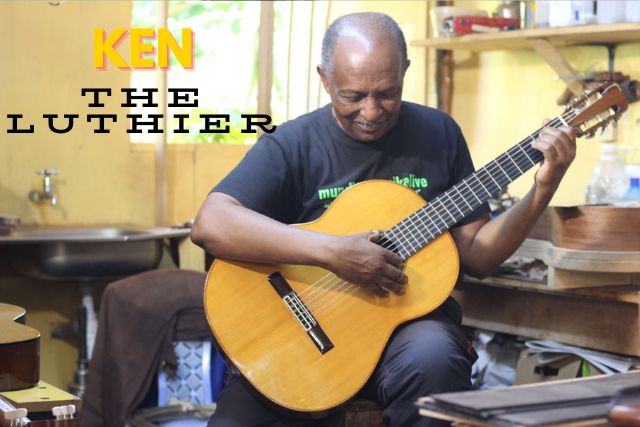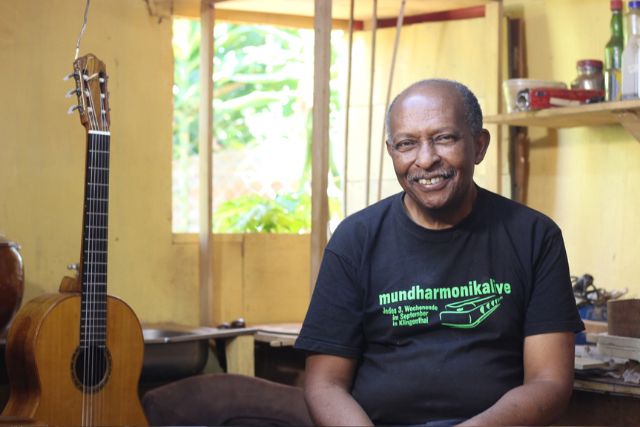
Ken Luthier
In the heart of Kikuyu, Kenya, we meet a dedicated luthier who has spent decades transforming raw materials into instruments that breathe life into music. Ken, a skilled craftsman, has been making guitars since 1971, turning his passion for working with his hands into a lifelong career.
Ken’s Luthier journey into guitar-making began in the rolling hills of Taita, where he attempted to carve his first guitar using only a machete. His first creation was an electric guitar, marking the beginning of a career that would span over five decades. Despite having a background in human resources, Ken’s passion for crafting stringed instruments never wavered. Over the years, he has made and customized guitars for renowned musicians, including Kato Change, Polycarp of Sauti Sol, Nyatiti for Makadem and Susan Owiyo.
Beyond creating guitars, Ken Luthier also repairs a wide range of stringed instruments, including traditional African instruments like the Kambanane and Nyatiti, as well as banjos, mandolins, sitars, and violins. His day-to-day work involves meticulously shaping, assembling, and repairing instruments in his workshop, beginning his craft as early as 7:00 AM each day.
The Art of Crafting a Guitar
The process of making a guitar from scratch is intricate and demands precision. Ken starts by determining the type of guitar he will create whether a steel-string acoustic, an electric, a semi-acoustic, or a solid-body bass guitar. He consults with clients to understand their preferences and sources materials accordingly.
Most of Ken’s materials are locally sourced from Kenya. The backs and sides of his acoustic guitars are typically made from Kenyan mahogany, which is abundant in the region. However, for high-end guitars, he imports spruce for the soundboard, as it is a worldwide favorite for its superior tonal quality.
The guitar-making process begins with preparing the wood, cutting, and shaping it to fit the required mold. The sides of the guitar are bent and glued into shape, linings are added for reinforcement, and the neck is carefully attached. Once the structure is assembled, Ken carves and attaches the fretboard and bridge before applying the final finish and adding the strings. Each guitar takes approximately six to eight weeks to complete, though he often works on multiple projects simultaneously to maximize efficiency.
A Global Reach

Ken’s craftsmanship has gained recognition beyond Kenya’s borders. He has received orders from international clients, including musicians from Finland and other countries. His unique approach incorporating African materials and designs sets his instruments apart in the global market.
What Makes Ken’s Guitars Unique?
While the general shape and design of guitars remain consistent, Ken’s work stands out due to his expertise and the unique materials he uses. He integrates African blackwood, a rare and high-quality wood, into his designs, producing instruments with distinctive tonal properties. Additionally, he customizes the aesthetic elements of his guitars by adding African-themed rosettes around the soundhole, making each piece a work of art.
A Legacy in the Making
Ken’s favorite instrument to craft is the classical nylon-string guitar, which he meticulously designs using a combination of imported spruce and local mahogany. If given the chance, he would love to make a guitar for jazz legend George Benson, envisioning an instrument crafted in Africa for a globally renowned artist.
Looking ahead, Ken Luthier is optimistic about the future of guitar-making in Kenya. He has noticed a growing interest among younger craftsmen and is actively contributing to the industry’s growth by training apprentices. His hope is that more Kenyan luthiers will emerge, taking the art of guitar-making to new heights in the coming years.
Ken the luthier’s story is a testament to passion, perseverance, and the beauty of handcrafted artistry. With every guitar he creates, he continues to leave a lasting impact on the world of music, one finely-tuned note at a time.





